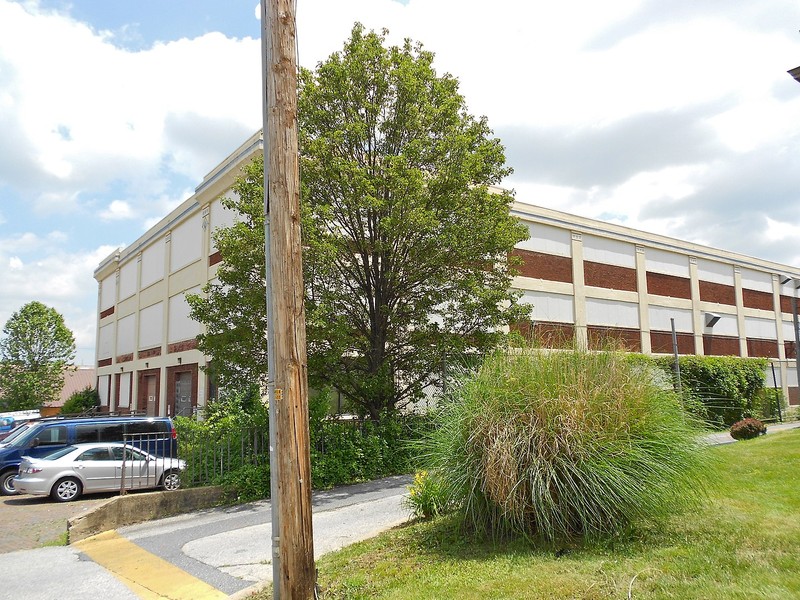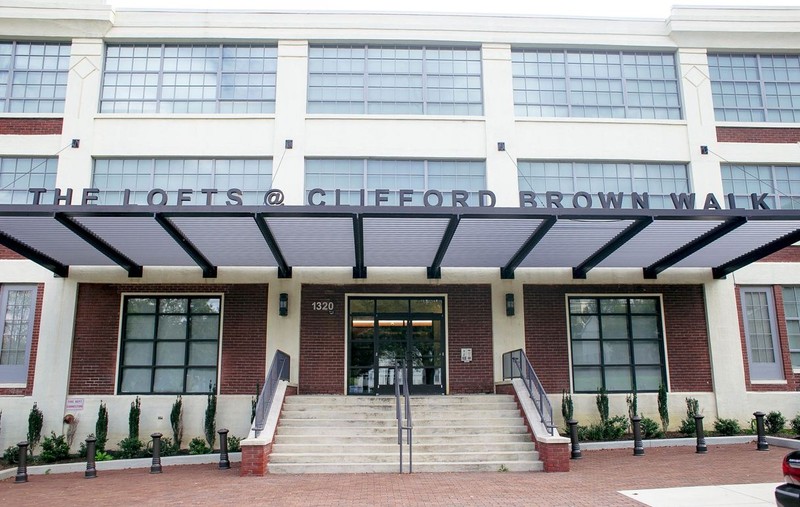New Castle Leather Raw Stock Warehouse (also known as the Kaumagraph Building and The Lofts at Clifford Brown Walk)
Introduction
Text-to-speech Audio
Images
New Castle Leather Raw Stock Warehouse

New Castle Leather Raw Stock Warehouse now known as The Lofts at Clifford Brown Walk

Backstory and Context
Text-to-speech Audio
Constructed in 1917, along with the Main Office Building located a few blocks away, the historic warehouse building enjoys an association with two world-renown leather companies, New Castle Leather Company and the Allied Kid Company, as well as the Kaumagraph Printing Company. Both leather companies were hugely successful and employed significant numbers of people in Wilmington. New Castle built the warehouse and used it to store substantial collections of partially-cured goatskins. Allied bought New Castle in 1933 and used the building for a few years before the Kaumagraph company purchased the building and used it for its specialty printing business.
Wilmington's leather industry began in 1828 and grew into the world's second-largest producer of Moroccan leather by the turn of the twentieth century. Wilmington's location near the Atlantic Ocean (thirty miles closer than Philadelphia) and at the apex of the Christina, Brandywine, and Delaware Rivers, along with an established seaport, allowed for easy transportation of leather goods to other markets. By 1870 larger mechanized leather factories replaced neighborhood tanyards, and mechanization allowed for increased production and profit. By the late nineteenth century, many of the employees involved with leather manufacturing trades comprised of Polish immigrants. At the turn of the century, Wilmington supported forty plants that employed 3,000 leatherworkers, which climbed to 6,000 leather-industry workers by 1933.
Richard Patzowsky founded New Castle Leather Company when he built a tannery on 11th and Poplar Streets in 1901. Patzowsky came to America from Prague at the age of eighteen and then spent seven years learning the trade by working as a manager for F. Blumenthal and Company. His New Castle Leather Company grew into the world's leading Moroccan leather manufacturer. Patzowsky's company flourished at a time when leather was used for making gloves, shoes, automobile seats, luggage, book covers, and hundreds of other items. Millions of goatskins, only partially cured, arrived in Wilmington's port from Asia and South America.
After he died in 1916, his friend and co-worker, J. Wirt Willis, took over the company and saw its growth continue, which forced the company to expand its tannery warehouse to a size of eight city blocks. The warehouse construction consisted of steel beams, concrete floors, brick and tiles laid between floor joists, and an expansive sprinkler system, all of which served as excellent designs to protect the tannery from fire. Still, a large fire on December 22, 1921, damaged the warehouses and leather. Regardless, the company recovered and continued to grow.
The culmination of several leather makers merging during the 1920s led to the Allied Kid Company's establishment in 1929. Four years later, in 1933, Allied Kid purchased New Castle Leather Company and, consequently, became Wilmington's largest manufacturer. However, there are no records to indicate that Allied used the historic warehouse to store goatskins. Instead, it appears that by the late 1930s, Allied Kid had already rented the property to the Kaumagraph Company. The New York specialty printing business started in 1902 but sought to move to Wilmington because its operations continued to expand despite the Great Depression.
During World War II, Kaumagraph produced for the U.S. Navy nylon maps printed on both sides that could be folded to a small size and did not disintegrate in water. The maps used nylon, an innovation at the time, and their production remained a secret to anyone outside the plant. With its basement, strong concrete and steel construction, the building also served as a bomb shelter during the war. After the war, notably during the 1950s, the company enjoyed substantial expansion, supporting more than 120 employees and working with affiliates in Canada (Kaumagraph Ltd.) and the U.K. (Kaumagraph Transfers, Ltd. of Manchester, England). By the 1970s, most store aisles included products with printing and designs created by Kaumagraph.
Today, the building supports rent-controlled apartments known as The Lofts at Clifford Brown, a sign of the latest form of urban renewal. But the warehouse building, along with the Spanish-design Main Office Building located at 1043 Clifford Brown Walk (traditionally 11th St. and Poplar St.), serve as reminders of Wilmington's once-thriving leather production industry, as well as the long success of the Kaumagraph printing business.
Cite This Entry
Powers, Mathew and Clio Admin. "New Castle Leather Raw Stock Warehouse (also known as the Kaumagraph Building and The Lofts at Clifford Brown Walk)." Clio: Your Guide to History. February 11, 2021. Accessed August 13, 2025. https://theclio.com/entry/126528
Sources
"Affordable luxury in the city!" Delaware Online. delawareonline.com. March 28, 2016. https://www.delawareonline.com/story/marketplace/real-estate/2016/03/25/affordable-luxury-city/82252024/.
Bowen, Patricia. "Nomination Form: The Main Office of the New Castle Leather Company." National Register of Historic Places. nps.gov. December 19, 1995. https://npgallery.nps.gov/GetAsset/c29ef1e1-8995-40f1-bd35-0640f1996cc1/.
"City History." The City of Wilmington, Delaware. wilmingtonde.gov. Accessed February 10, 2021. https://www.wilmingtonde.gov/about-us/about-the-city-of-wilmington/city-history.
Hoffecker, Carol E. Wilmington, Delaware: Portrait of an Industrial City, 1830-1910. Charlottesville: The University Press of Virginia, 1974. Digital copy found at delaware.gov. Accessed February 10, 2021. https://archivesfiles.delaware.gov/ebooks/Wilmington,_Delaware_Portrait_of_an_Industrial_City.pdf.
Powers, Mathew. "Main Office of the New Castle Leather Company and Allied Kid Company." Clio: Your Guide to History. February 10, 2021. Accessed February 10, 2021. https://www.theclio.com/entry/126513.
Ross, William Edward. National Magazine, Vol. XLVII1, No. 1, January 1919.
Thompson, Priscilla M. "Nomination Form: Allied Kid or New Castle Leather Raw Stock Warehouse." National Register of Historic Places. nps.gov. January, 1983. https://npgallery.nps.gov/GetAsset/e8a0e36f-f0e1-40a0-8d7b-0daba2991f9b/.
By Smallbones - Own work, CC0, https://commons.wikimedia.org/w/index.php?curid=26600228
https://www.loftsatcliffordbrownwalk.com/Gallery.aspx#mosaic-gallery-0-1

